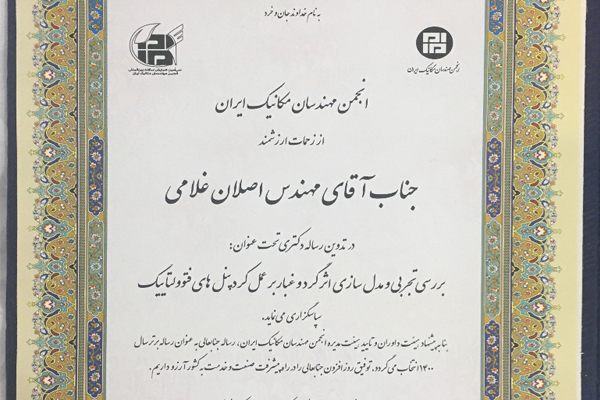
The PhD thesis by a SBU graduate was introduced as the best thesis in the 30th Annual International Conference of Iranian Association of Mechanical Engineers.
The thesis by Dr. Aslan Gholami, a graduate of the Faculty of Mechanical and Energy Engineering, entitled "Experimental Study and Modeling of the Effect of Dust on the Performance of Photovoltaic Panels" was introduced and praised as the top thesis.
Dr. Gholami composed this thesis under the supervision of Dr. Mohammad Ameri and Dr. Majid Zandi and defended it in August 2021 with an excellent degree (19.80 out of 20). The results of this research have been published in 3 Persian articles and 12 International articles (ISI).
The abstract of this thesis is as follows:
The performance of photovoltaic solar systems in converting solar energy into electricity is a function of environmental conditions. Many regions with high solar potential to install photovoltaic solar systems are arid regions, in which dust activities severely affect the output performance of solar photovoltaic systems. Due to the close dependence of dust activities on climatic conditions in each region, comprehensive modeling is necessary to predict the impact of dust on the performance of photovoltaic solar panels. In addition, lack of thorough studies in this field in Iran is very tangible. The current study is pursuing to provide a comprehensive model to predict the behavior of photovoltaic solar panels in different climatic conditions with the aim of overcoming the mentioned challenges.
Both experimental and theoretical investigations have been conducted to advance the present study. The experimental section of this research includes experiments under laboratory control conditions and outdoor environmental measurements. In the theory section, combinations of a double-diode circuit model with hybrid analytical-numerical solution and several mathematical-experimental models to extend the modeling range and increase the accuracy of the final model was proposed, to estimate the characteristic curves of photovoltaic panels. In addition, optical and thermal simulations of the photovoltaic solar panel were carried out to more accurately investigate the temperature distribution in the panel as well as to model the airflow around it.
Under standard test conditions, the proposed double-diode circuit model estimates the characteristic curves of a photovoltaic solar panel with very high accuracy and an estimation error of less than 0.1%. However, in conditions other than the standard test conditions, the developed double-diode circuit model along with mathematical-experimental models should be used. Using stepwise multivariable linear and non-linear regressions, various mathematicalexperimental models were proposed to estimate cell irradiation, cell temperature, electrical behavior of photovoltaic solar panels under different climatic conditions and in the presence or absence of dust. The results of this study showed that neglecting dust accumulation effects, can lead to errors in estimating electrical behavior of more than 35%.
In addition to computational simplicity, the derived mathematical-experimental models in the current study showed a very high accuracy and are therefore recommended to be utilized in combination with the diode circuit model to develop the final proposed model. Applying the final developed double-diode circuit model of this study, especially in regions such as Iran, which are struggling with dust problem, will improve the accuracy of the simulation and reduced the prediction errors by 35%.

